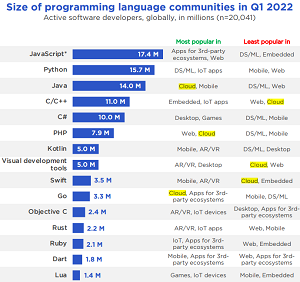News
Most/Least Popular Programming Languages for Cloud Development
What programming language is No. 1 for cloud development? Java, of course.
Java tops most lists that rank the most popular programming languages for cloud development. But a new report from Slashdata provides a twist on such rankings, as it also lists the languages that are least popular. Specifically, that information is included in the firm's quarterly series of State of the Developer Nation reports, now in its 22nd edition for Q1 2022.
Java tops the popularity list, unsurprisingly, also being identified as being most popular in mobile while being least popular for data science/machine learning and web.
Other languages being listed as most popular for cloud include:
- PHP (also popular in web)
- Go (also popular in apps for third-party ecosystems)
In the least popular side of things, the languages are:
- C/C++ (also least popular for web)
- Visual development tools (also least popular for web)
- Swift (also least popular in embedded development)
Here's the full list, with "cloud" highlighted:
 [Click on image for larger view.] Size of Programming Language Communities in Q1 2022 (source: Slashdata).
[Click on image for larger view.] Size of Programming Language Communities in Q1 2022 (source: Slashdata).
"Java is one of the most important general-purpose languages, as well as the cornerstone of the Android app ecosystem," Slashdata said. "Although it has been around for more than two decades now, it keeps experiencing strong and steady growth. Nearly 5M developers have joined the Java community since the beginning of 2021. Our data suggest that Java's growth is fueled not only by the usual suspects, i.e. backend and mobile development, but also by its rising adoption in AR/VR projects."
The Slashdata "most popular" chart aligns with many of the vast amount of best-programming-languages-for-cloud rankings available on the web, including:
-
CMARIX Technolabs (see here):
- Java
- PHP
- ASP.NET
- Python
- Go
- Ruby on Rails
- JavaScript
-
GeeksforGeeks (see here):
- Python
- Go
- Ruby
- Java
- ASP.NET
-
Chakray (see here)
- Java
- ASP.NET
- PHP
- Python
- Ruby
-
Qulix Systems (see here)
- Java
- PHP
- Python
- Go
- Ruby
- JavaScript
- Node.js
- ASP.NET
-
HackerNoon (see here)
- Java
- PHP
- ASP.NET
- Python
- Go
- Ruby
- Node.js
You get the picture. There are plenty more, but all of the above serve to clearly show what industry pundits most commonly see as the core group of programming languages most suitable for cloud computing.
Other language-related data points of the Slashdata report include:
- JavaScript remains the most popular programming language for the tenth survey in a row, with close to 17.5M developers worldwide using it.
- Since surpassing Java in popularity two years ago, Python has remained the second most widely adopted language behind JavaScript. Python now counts 15.7M users.
- Rust has nearly tripled in size in the past 24 months, from just 0.6M developers in Q1 2020 to 2.2M in Q1 2022.
- Go and Ruby are important languages in backend development but Go has grown more than twice as fast in the past year in absolute terms.
Here's what Slashdata said about its programming language ranking:
It can be hard to assess how widely used a programming language is. The indices available from players like Tiobe, Redmonk, Stack Overflow's yearly survey, or GitHub's State of the Octoverse are great, but offer mostly relative comparisons between languages, providing no sense of the absolute size of each community. They may also be biased geographically or skewed towards certain fields of software development or open source developers.
The estimates we present here look at active software developers using each programming language; across the globe and across all kinds of programmers. They are based on two pieces of data. First is our independent estimate of the global number of software developers, which we published for the first time in 2017. We estimate that, as of Q1 2022, there are 31.1 million active software developers in the world.
Second is our large-scale, low-bias surveys which reach tens of thousands of developers every six months. In the surveys, we have consistently asked developers about their use of programming languages across ten areas of development, giving us rich and reliable information about who uses each language and in which context.
About the Author
David Ramel is an editor and writer at Converge 360.